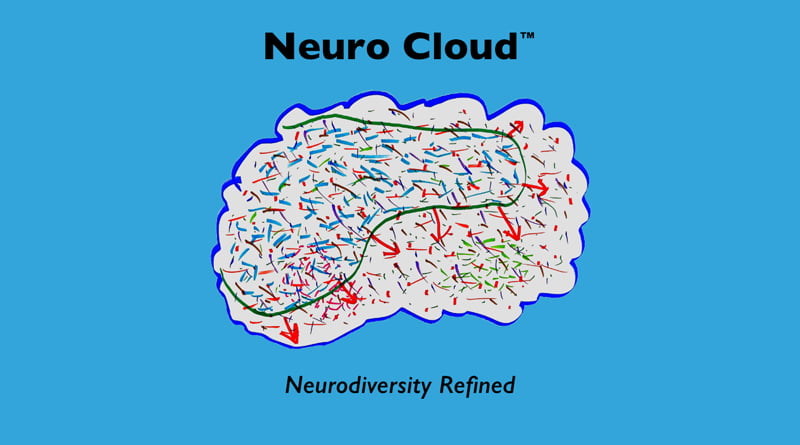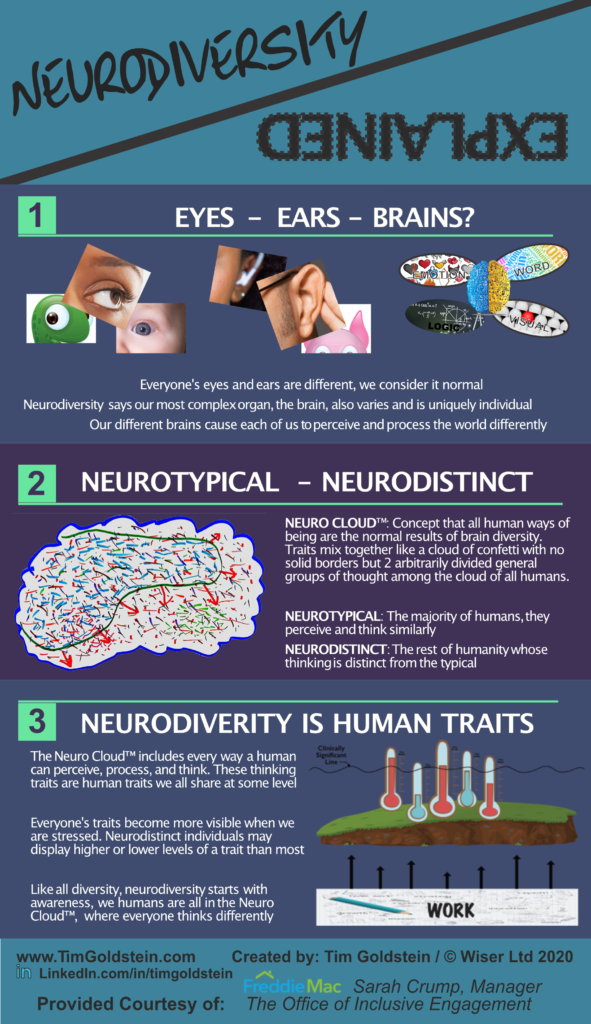
Neuro Cloud & Neurodistinct: Neurodiversity Refined
By Tim Goldstein
Refining the Concept of “Neurodiversity”
Australian social scientist Judy Singer coined the word “neurodiversity” in her theses paper. It was a great advance in viewing the relationship of an individual with certain traits or group of traits to the to the larger group, the maker of societal norms. Her concept uses terminology which, while appropriate in the academic setting of her work, is hard to approach for the average person, confusing in how the items fits in the whole, does not align with how we speak of other human capability challenges, and uses a word that make groups of people sound bad. Judy’s concept has created a movement of seeing people with distinctly different perceiving, processing, and thinking patterns as normal human variation, not as broken human needing to be fixed to be “normal”.
The Neuro Cloud™
In science, concepts mature and develop as others add to the idea. This has happened with neurodiversity as it has moved from academic discussion to real life identities. As with much science, the academic body of knowledge tends to be unapproachable for the lay person. With academic concepts, no matter how elegant, there needs to be a “productizing” of the concept to make it relatable and easy to understand from a high level. The Neuro Cloud™ is my model to put Judy’s great work into a mass market package. Every bit of it has been considered from the point of “can an average person get the drift”.
Many autistic people are already screaming “If they are too stupid to get it, that’s their problem.” While there are many legitimate reasons involving autism which can lead to this incorrect conclusion, I once firmly held it. I finally recognized I could be “right” or I could apply the lessons of an entire industry devoted to getting people to think different, marketing. I finally recognized explaining something in a way the receiver can understand is not “dumbing it down”, but actually “smartening it up” so more people could benefit, not just the gifted few.
I set out with a few specific goals. It had to be simple enough it could be taught to a 6th grader. It had to align with the way we speak about all other types of diversity. It had to resolve that non-neurotypical is often called neurodiverse or neurodivergent. Finally, it has to have an appealing term for non-neurotypical that almost makes everyone want to be one.
I present Neurodiversity Explained:
Click Here to Download a PDF version
Let’s examine how well I met the goals of this refinement. I believe the infographic is easily understood allowing most to get the key point of, different but normal in the range of neurodiversity for humans. The other goals fall under two broad categories, aligning neurodiversity and diversity and a word for non-neurotypical which give a sense of desirability and pride. I’ll start with aligning with diversity.
Diversity and Neurodiversity
Starting at the top and we have the concept of diversity meaning, the range of all humans generally around visible or other characteristics, being normal and equal. Neurodiversity is this same concept of all humans only applied to cognition. Next is the term diverse. This is a term used to describe the makeup of a group in relationship to normal distribution. We speak of it as if a measure of a group’s diversity. XYZ company has a very diverse staff. Neurodiverse is the same, a term to talk about the relative measure of the diversity of a group in regard to their perceiving, processing, and thinking styles. Everything else is just the names we are using for the groups.
Neurodistinct
In the world of neurodiversity there are two primary groups, neurotypical which seems to be relatively universally understood and accepted and non-neurotypical where we have confusion. With Neurodiversity being all humans and neurodiverse now being the “how much” descriptor that brings the term neurodivergent. Looking at this word from the, how things influence people marketing perspective neurodivergent is a loser. Just like many science terms, they need popular translations for the public to get it. Instead of the negative, separating, divisive term, I coined Neurodistinct.
Neurodistict wins on many fronts. It is easy to spell and say. It embodies something people want to be, distinct. Finally, it eliminates the artificial DSM imposed hard line with a definition of “thinks in a manner which is distinctly different than the majority.”
I hope this give you both understanding in why I refined neurodiversity and motivation to adopt the new “we are the cool group” term, Neurodistinct.
This piece was originally presented here, and is republished with the author’s kind permission.
Diagnosed with Asperger’s at 54, Denver-based consultant Tim Goldstein is a Neurodiverse Communications Specialist –the only one doing what he does. He trains all types of employees including those who are neurodiverse and maybe autism how each other functions.
With deep experience in business and consulting, Tim, helps companies recognize and overcome the challenges integrating the neurodiverse. Using his Neuro Cloud™ concept, he explains the Spock-like logical approach common among the neurodiverse. Tim has lectured on his concepts at Cornell and presented them at Vanderbilt. His book, Geeks Guide to Interviews: 15 Critical Items for the Technical Type, is available to help people better understand challenges to the autistic in the workforce.






